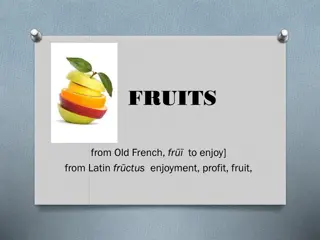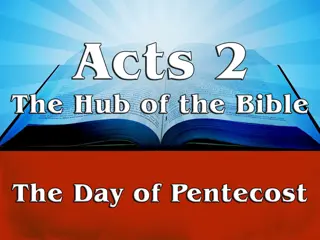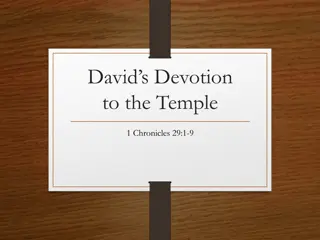Understanding Second Temple Jewish Holidays: Passover and First Fruits
Delve into the spiritual significance of Second Temple Jewish holidays like Passover and First Fruits, exploring their temporal and future implications as detailed in the Bible. Discover how these celebrations resonate with redemption, thanksgiving, and the promise of eternal life in Christ.
Download Presentation

Please find below an Image/Link to download the presentation.
The content on the website is provided AS IS for your information and personal use only. It may not be sold, licensed, or shared on other websites without obtaining consent from the author. Download presentation by click this link. If you encounter any issues during the download, it is possible that the publisher has removed the file from their server.
E N D
Presentation Transcript
Discipleship: Discipleship: An An Introduction to Introduction to Systematic Theology and Systematic Theology and Apologetics Apologetics The Doctrines of Redemption: Passover The Heights Church March 25, 2018
Second Temple Spring Jewish Holidays Passover (March 30 April 6 2018) Passover Nisan 14 -15 First Fruits Nisan 16 -17 Unleavened Bread Nisan 15 - 22 The Feast of Unleavened Bread is often confused with Passover but has its own particular spiritual significance. (By Second Temple times, Passover, First Fruits and Unleavened bread had been combined into one holiday. To this day Jews consider the eight days as Passover.) Whereas Passover speaks of the Festival of Redemption, the Feast of Unleavened Bread reminds mankind of the need to live a life without sin and First Fruits is a time of thanksgiving for the barley harvest and the promise of future harvests.
Second Temple Spring Jewish Holidays Passover Nisan 14 Nisan 14- -15 15 Season: Spring(new beginning) Temporal significance for Israel under the Law: Redemption from bondage in Egypt Future significance for all God s people under grace: Believers in Christ are redeemed from bondage of sin. NT event: The Crucifixion Scripture reference: knowing that you were ransomed from the futile ways inherited from your forefathers, not with perishable things such as silver or gold, but with the precious blood of Christ, like that of a lamb without blemish or spot. (1 Peter 1:18-19)
Second Temple Spring Jewish Holidays First fruits Nisan 16-17 Season: Spring(first grain harvest) Temporal significance for Israel under the Law: Thanksgiving for and presentation to God of the first fruits of the grain harvest; and the promise of the harvest to come. Future significance for all God s people under grace: Christ is the first to rise from the dead and the promise of the resurrection and eternal life for all who truly believe in him. NT event: The resurrection of Christ Scripture reference: But in fact Christ has been raised from the dead, the first fruits of those who have fallen asleep. For as by a man came death, by a man has come also the resurrection of the dead. For as in Adam all die, so also in Christ shall all be made alive. (1 Corinthians 15:20-22)
Second Temple Spring Jewish Holidays First fruits Nisan 16-17 There are three first fruits holidays mentioned in the Bible. All three required all men of Israel to come to the sanctuary in Jerusalem. They would offer the first fruits of the different harvests that took place during the year. Passover week fell early in the spring and marked the barley harvest. In the later spring, wheat ripened and was harvested at Pentecost. Tabernacles took place in the fall when the final harvest of the year was brought in, which included olives and grapes.
Second Temple Spring Jewish Holidays - Unleavened Bread Nisan 15 -22 Season: Spring(new life) Temporal significance for Israel under the Law: Purging of all leaven (symbolic of sin) from the homes Future significance for all God s people under grace: Christ, the first to rise from the dead is the promise of resurrection and eternal life for all who truly believe in Him. NT event: (1) sanctification; (2) justification Scripture reference: (1)Cleanse out the old leaven that you may be a new lump, as you really are unleavened. For Christ, our Passover lamb, has been sacrificed. (1 Corinthians 5:7) (2)For our sake he made him to be sin who knew no sin, so that in him we might become the righteousness of God. (2 Corinthians 5:21)
The Old Testament Sacrificial System Major Jewish Holidays (Unleavened Bread Nisan 15-22) Adam, sinned and infected all who would come after him with human nature or sin. Every person has inherited his human nature. The word chametz not only means leavening, but it means bitter or sour. When sin entered the human race, it was the cause of bitterness among people. Leaven typifies sin. Just as chametz causes the bread to be puffed up, so sin causes a person to have an inflated ego. The message of the Feast of Unleavened Bread is that the cycle of sin can be broken. People can be free from the guilt, the penalty, and the power of sin. Bitterness caused by sin can be extracted from the life that has been redeemed, and the redeemed person can have a new beginning, a new birth as it is called in the New Testament. The Feast of Unleavened Bread is God s message that people can be free from sin.
Second Temple Spring Jewish Holidays - The Seder Celebration On the 10th of Nisan each family selected a blemish free lamb and took it home. On the 14th of Nisan the lamb was killed and roasted in preparation for the Passover meal (Seder) The Seder began with the Kiddush (means sanctification) consecrated the occasion and the meal to God over the first cup of wine. Blessed are you, O Lord our God, who has created the fruit of the vine. Blessed are you O Lord our God, who has sustained us and enabled us to reach this season. And he took a cup, and when he had given thanks he said, "Take this, and divide it among yourselves. For I tell you that from now on I will not drink of the fruit of the vine until the kingdom of God comes. (Luke 22:17-18)
Second Temple Spring Jewish Holidays - The Seder Celebration Washing of the hosts hands. Jesus, knowing that the Father had given all things into his hands, and that he had come from God and was going back to God, rose from supper. He laid aside his outer garments, and taking a towel, tied it around his waist. Then he poured water into a basin and began to wash the disciples' feet and to wipe them with the towel that was wrapped around him. (John 13:3-5) Food brought in on a portable table: Lettuce (bitter herb) dipped in salt water or vinegar and given to each person. Food removed to raise curiosity. Pouring of the second cup of wine.
Second Temple Spring Jewish Holidays - The Seder Celebration Traditional questions asked by the youngest son: On all other nights we eat all kinds of herbs, but this night only bitter herbs. Why do we dip the herbs twice? Commemorate the dipping of the hyssop in blood, and the second dipping referred to the bitter herbs that were eaten with the paschal lamb at the conclusion of the meal. Why is this night different from all other nights? On all other nights we eat leavened or unleavened bread but on this night only unleavened bread. No traditional answer dependent on understanding of the child. On all other nights we eat meat roasted, stewed or boiled, but on this night why only roasted meat? No traditional answer dependent on understanding of the child. Father gives a lesson on the history of Israel. (Call of Abraham to the deliverance from Egypt and giving of the Law.) Food is brought back and the father answers the questions. Sing first part of the Hallel (Psalms 113 and 114). (hallel means praise)
Second Temple Spring Jewish Holidays - The Seder Celebration Drink second cup of wine Second washing of hands (act of respect for the bread they were about to eat.) Host broke one wafer and then thanked God for the bread and for the commandment to eat unleavened bread. Piece of bread dipped in bitter herbs and Charoseth (sweet mixture of apples and nuts) and given to each person. Jesus answered, "It is he to whom I will give this morsel of bread when I have dipped it." So when he had dipped the morsel, he gave it to Judas, the son of Simon Iscariot. (John 13:26) The lamb is eaten. Aphikomen (after dish) For I received from the Lord what I also delivered to you, that the Lord Jesus on the night when he was betrayed took bread, and when he had given thanks, he broke it, and said, "This is my body which is for you. Do this in remembrance of me." (1 Corinthians 11:23-24)
Second Temple Spring Jewish Holidays - The Seder Celebration Third washing of hands. Third cup of wine (represented the blood of the lamb) And he took a cup, and when he had given thanks he gave it to them, saying, "Drink of it, all of you, for this is my blood of the covenant, which is poured out for many for the forgiveness of sins. (Matthew 26:27-28) In the same way also he took the cup, after supper, saying, "This cup is the new covenant in my blood. Do this, as often as you drink it, in remembrance of me." For as often as you eat this bread and drink the cup, you proclaim the Lord's death until he comes. (1 Corinthians 11:25 - 26) Second part of the Hallel (Psalms 115 118)
Second Temple Spring Jewish Holidays - The Seder Celebration Fourth cup of wine Closing hymn All thy works shall praise Thee Jehovah, our God from everlasting to ever lasting thou art God and beside thee we have no King, Redeemer or Savior. And when they had sung a hymn, they went out to the Mount of Olives. (Matthew 26:30) The aphikomen would be become part of the seder after the destruction of the Temple in 70 A.D. From the Christian perspective Jesus fulfills both the prophetic symbolism of the unleavened bread and the Passover lamb.
Second Temple Spring Jewish Holidays When is Easter? Easter is observed on the first Sunday following the full moon that comes on or after the vernal equinox This full moon is normally the full moon which takes place on the 14th or 15th day of Nisan. Thus in most years Easter is celebrated on the Sunday following Passover. The early church was faced with the following conflict in dates: Jesus rose on a Sunday, but Passover can fall on any day of the week. So the early church saw two options: 1. Celebrate Easter in strict relation to the 14th of Nisan without regard for the day of the week, or 2. Determine a system whereby Easter could always be celebrated on a Sunday. The Council of Nicea in 325 A.D. eventually adopted the current system of celebrating Easter on the Sunday following the full moon after the vernal equinox. Since the Second Vatican Council Roman Catholics have discussed fixing the date of Easter on a set Sunday such as the first or second Sunday in April. However, no progress has been made thus far towards such a change.























